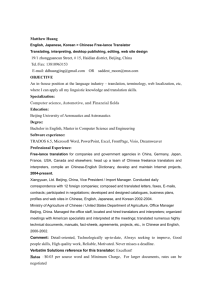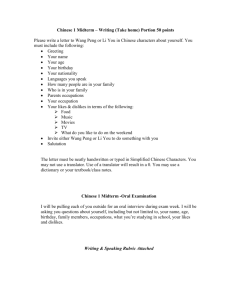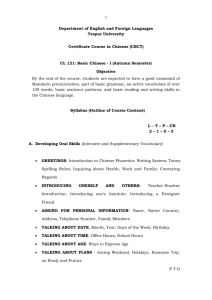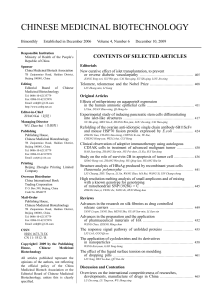C E P HINESE
advertisement
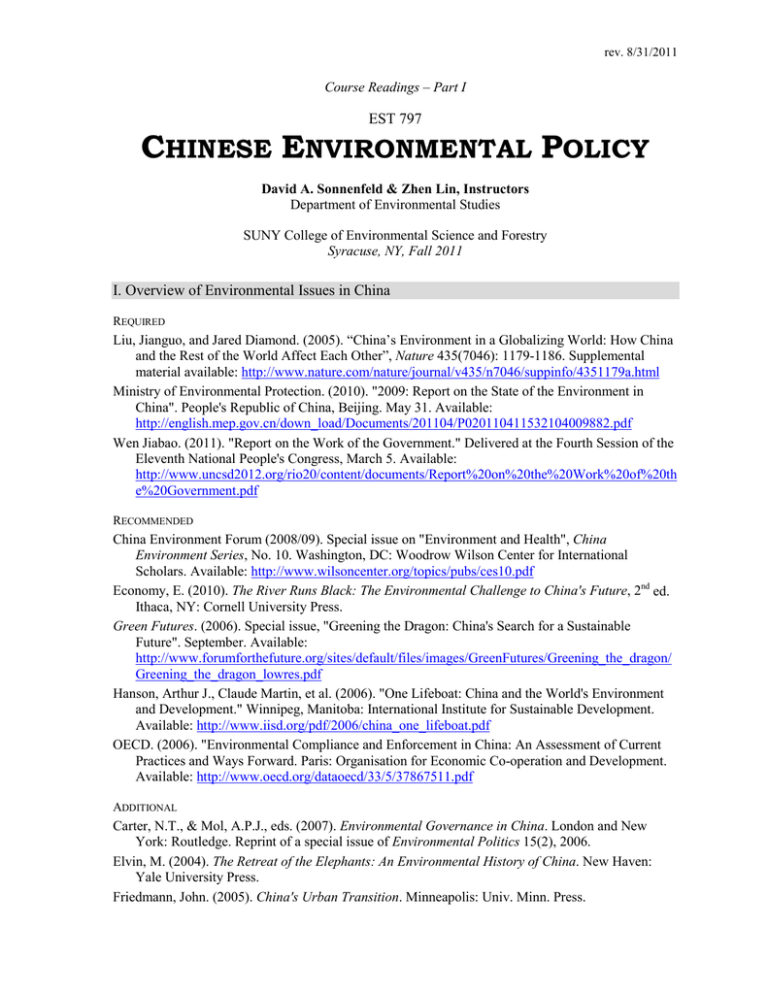
rev. 8/31/2011 Course Readings – Part I EST 797 CHINESE ENVIRONMENTAL POLICY David A. Sonnenfeld & Zhen Lin, Instructors Department of Environmental Studies SUNY College of Environmental Science and Forestry Syracuse, NY, Fall 2011 I. Overview of Environmental Issues in China REQUIRED Liu, Jianguo, and Jared Diamond. (2005). “China’s Environment in a Globalizing World: How China and the Rest of the World Affect Each Other”, Nature 435(7046): 1179-1186. Supplemental material available: http://www.nature.com/nature/journal/v435/n7046/suppinfo/4351179a.html Ministry of Environmental Protection. (2010). "2009: Report on the State of the Environment in China". People's Republic of China, Beijing. May 31. Available: http://english.mep.gov.cn/down_load/Documents/201104/P020110411532104009882.pdf Wen Jiabao. (2011). "Report on the Work of the Government." Delivered at the Fourth Session of the Eleventh National People's Congress, March 5. Available: http://www.uncsd2012.org/rio20/content/documents/Report%20on%20the%20Work%20of%20th e%20Government.pdf RECOMMENDED China Environment Forum (2008/09). Special issue on "Environment and Health", China Environment Series, No. 10. Washington, DC: Woodrow Wilson Center for International Scholars. Available: http://www.wilsoncenter.org/topics/pubs/ces10.pdf Economy, E. (2010). The River Runs Black: The Environmental Challenge to China's Future, 2nd ed. Ithaca, NY: Cornell University Press. Green Futures. (2006). Special issue, "Greening the Dragon: China's Search for a Sustainable Future". September. Available: http://www.forumforthefuture.org/sites/default/files/images/GreenFutures/Greening_the_dragon/ Greening_the_dragon_lowres.pdf Hanson, Arthur J., Claude Martin, et al. (2006). "One Lifeboat: China and the World's Environment and Development." Winnipeg, Manitoba: International Institute for Sustainable Development. Available: http://www.iisd.org/pdf/2006/china_one_lifeboat.pdf OECD. (2006). "Environmental Compliance and Enforcement in China: An Assessment of Current Practices and Ways Forward. Paris: Organisation for Economic Co-operation and Development. Available: http://www.oecd.org/dataoecd/33/5/37867511.pdf ADDITIONAL Carter, N.T., & Mol, A.P.J., eds. (2007). Environmental Governance in China. London and New York: Routledge. Reprint of a special issue of Environmental Politics 15(2), 2006. Elvin, M. (2004). The Retreat of the Elephants: An Environmental History of China. New Haven: Yale University Press. Friedmann, John. (2005). China's Urban Transition. Minneapolis: Univ. Minn. Press. Sonnenfeld/Lin SUNY-ESF -2- EST 797 Fall 2011 Ministry of Environmental Protection, People's Republic of China. (2009). "2008: Report on the State of the Environment in China". Beijing, June 4. Available: http://english.mep.gov.cn/down_load/Documents/201002/P020100225377359212834.pdf Scott, J. C. (2009). The Art of Not Being Governed. New Haven: Yale University Press. Shapiro, J. (2001). Mao's War against Nature: Politics and the Environment in Revolutionary China. New York: Cambridge University Press. Tilt, B. (2010). The Struggle for Sustainability in Rural China. New York: Columbia University Press. Zhang Kun-min. (2001). Policies and Actions on Sustainable Development in China. Beijing: China Environmental Science Press. Ziran zhi you (Friends of Nature), eds. (2010). Zhongguo huanjing fazhan baogao (2010). (Annual Report on Environment Development in China, 2010). Beijing: Shehui kexue wenjian chubanshe. Published in English by E.J.Brill, Leiden, the Netherlands. II. Structure and Process of Environmental Policymaking REQUIRED Liu Jingjing, and Adam Moser. (2011). "Environmental Law – China". Pp. 220-223 in The Law and Politics of Sustainability, vol. 3 of the Berkshire Encyclopedia of Sustainability. Great Barrington, MA: Berkshire Publishing Group. Wang, Alex. (2007). "The Role of Law in Environmental Protection in China: Recent Developments," Vermont Journal of Environmental Law 8(2):195-224. Wang Canfa. (2007). "Chinese Environmental Law Enforcement: Current Deficiencies and Suggested Reforms," Vermont Journal of Environmental Law 8(2):159-194. Zhang Kun-min, and Zong-guo Wen. (2009). "Review and Challenges of Policies of Environmental Protection and Sustainable Development in China," Journal of Environmental Management 88(4): 1249-1261. RECOMMENDED Jahiel, Abigail R. (1998). “The Organization of Environmental Protection in China,” China Quarterly 156: 757-787, School of Oriental and African Studies. Lo, C., Fryxell, G. and Wong, W. (2006). "Effective Regulations with Little Effect? The Antecedents of the Perceptions of Environmental Officials on Enforcement Effectiveness in China," Environmental Management 38(3): 388-410. Lo, C.W.H., and Tang, S. Y. (2006). "Institutional Reform, Economic Changes, and Local Environmental Management in China: The Case of Guangdong Province," Environmental Politics 15: 190-210. Orts, E.W. (2003). “Environmental Law with Chinese Characteristics,” William and Mary Bill of Rights Journal 11: 545-567. Stern, Rachel. (2010). "On the Frontlines: Making Decisions in Chinese Civil Environmental Lawsuits," Law & Policy 32(1): 79-103. Van Rooij, Benjamin. (2006). "Implementation of Chinese Environmental Law: Regular Enforcement and Political Campaigns," Development and Change 37(1): 57-74. Van Rooij, B., and Lo Wing-Hung C. (2010). "Fragile Convergence: Understanding Variation in the Enforcement of China’s Industrial Pollution Law," Law & Policy 32(1): 14-37. Sonnenfeld/Lin SUNY-ESF -3- EST 797 Fall 2011 Yang Chun-Xi, John W. Head, and Liu Sheng-Rong. (1994). "China's Treatment of Crimes Against the Environment: Using Criminal Sanctions to Fight Environmental Degradation in the PRC," Journal of Chinese Law 8(2): 145-184. Available: http://kuscholarworks.ku.edu/dspace/bitstream/1808/7482/1/Head_8JChineseL145(1994).pdf. ADDITIONAL VJEL. (2007). Special issue on "China in Transition: Environmental Challenges in the Far East," Vermont Journal of Environmental Law 8(2). Available: http://www.vjel.org/journal/VJEL10051.html Van Rooij, Benjamin. (2006). Regulating Land and Pollution in China: Lawmaking, Compliance, and Enforcement. Theory and Cases. Ph.D. Thesis, Leiden University, the Netherlands. Available: https://openaccess.leidenuniv.nl/bitstream/handle/1887/5433/Thesis.pdf?sequence=1 Wen Zongguo. (2010). Environmental Policy in Contemporary China: Formation, Characters and Trends. Beijing: Chinese Environmental Science Press. 温宗国编著: 《当代中国的环境政策:形成、特点与趋势》,中国环境科学出版社(2010) III. Selected Case Studies (Air, Water, Natural Resources) REQUIRED Zhang Junfeng, et al. (2010). "Environmental Health in China: Progress towards Clean Air and Safe Water," Lancet 375: 1110-1119. Kendy, Eloise, et al. (2007). "Can Urbanization Solve Inter-sector Water Conflicts? Insights from a Case Study in Hebei Province, North China Plain," Water Policy 9 (Supp 1): 75-93. Zhong Lijin, and Arthur P.J. Mol. (2010). "Water Price Reforms in China: Policy-Making and Implementation," Water Resources Management 24(2):377-396. RECOMMENDED Chan Chak K., and Xiaohong Yao. (2008). "Air Pollution in Mega Cities in China," Atmospheric Environment 42: 1-42. Cheung Kui Yin, and Tuen Mun. (2010). "Economic Analysis of the Beijing Green Olympics: Implications on Environmental Protection in China," International Journal of Economics and Finance 2(3):104-113. Larsen, Thorjorn, et al. (2006). "Acid Rain in China," Environmental Science & Technology, January 15, pp. 418-425. Ma Jinzhu, et al. (2009). "Sources of Water Pollution and Evolution of Water Quality in the WuWei Basin of Shiyang River, Northwest China," Journal of Environmental Management 90(20): 11681177. Mol, Arthur P.J. (2011). "China's Ascent and Africa's Environment," Global Environmental Change 21(3):785-794. Xu, Jintao, et al. (2006). "China's Ecological Rehabilitation: Unprecedented Efforts, Dramatic Impacts, and Requisite Policies," Ecological Economics 57(4): 595-607. Wang, Mark, et al. (2008). "Rural Industries and Water Pollution in China," Journal of Environmental Management 86: 648-659. Zhong Lijin, Arthur P.J. Mol, and Tao Fu. (2008). "Public-Private Partnerships in China's Urban Water Sector," Environmental Management 41(6): 863-877. Sonnenfeld/Lin SUNY-ESF -4- EST 797 Fall 2011 ADDITIONAL Edmonds, Richard Louis, ed. (2000). Managing the Chinese Environment. New York: Oxford University Press. Hyde, William F., Brian Belcher, and Jintao Xu, eds. (2003). China's Forests: Global Lessons from Market Reforms. Washington, DC: Resources for the Future. Ho, Peter, and Eduard B. Vermeer. (2006). China's Limits to Growth: Greening State and Society. Hoboken, NJ: Wiley-Blackwell. Reprint of a special issue of Development and Change 37(1), 2006. Mol, Arthur P.J., and Joost C.L. van Buuren, eds. (2003). Greening Industrialization in Asian Transitional Economies. Lanham, MD: Lexington. Office of the Leading Group on Promotion of Sustainable Development Strategy, P.R. China (April 2008). The Review of Sustainable Development China: Agriculture, Rural Development, Land, Drought and Desertification. Document submitted to the 16th Session of the Commission on Sustainable Development of the United Nations, May 5-6 2008, New York. Rock, Michael T. (2002). Pollution Control in East Asia: Lessons from Newly Industrializing Economies. Washington DC: RFF Press. Yin, Runshen, ed. (2009). An Integrated Assessment of China's Ecological Restoration Programs. New York: Springer. IV. Eco-Civilization: Integrating Environment and Development REQUIRED Jin Yong. (2008). "Ecological Civilization: from Conception to Practice in China," Clean Technology & Environmental Policy 10: 111-112. Greene, Herman F. (2010). "China and Ecological Civilization". Paper presented at the United Nations, May 7. Guo Jinfu, et al. (2009). "Research on Eco-ethics and Eco-civilization's Construction in Chinese Ethnic Regions," Journal of Sustainable Development 2(3):122-126. Mol, A.P.J. (2006). "Environment and Modernity in Transitional China: Frontiers of Ecological Modernization," Development and Change 37(1): 29-56. Zhang ZhongXiang. (2010). "China in the Transition to a Low-carbon Economy," Energy Policy 38(11): 6638-6653. RECOMMENDED Wang Chunmei, and Zhaolan Lin (2010). "Environmental Policies in China over the Past 10 Years: Progress, Problems and Prospects." Paper presented at the Annual Conference of the International Society for Environmental Information Sciences (ISEIS). Wang Lijun. (2010). "The Changes of China’s Environmental Policies in the Latest 30 years". Paper presented at the Annual Conference of the International Society for Environmental Information Sciences (ISEIS). Zhang Kun-ming, Wen, Z.G. (2008). "Review and Challenges of Policies of Environmental Protection and Sustainable Development in China," Journal of Environmental Management 88: 1249-1261. Zhang Lei, A.P.J. Mol, and D.A. Sonnenfeld (2007). “The Interpretation of Ecological Modernisation in China,” Environmental Politics 16(4): 659-668. Sonnenfeld/Lin SUNY-ESF -5- EST 797 Fall 2011 ADDITIONAL Fang, Yiping, and Yong Zeng. (2007). "Balancing Energy and Environment: The Effect and Perspective of Management Instruments in China," Energy 32(12):2247-2261. Pintér, László. (2006). "International Experience in Establishing Indicators for the Circular Economy and Considerations for China." Report for The World Bank. May. Available: http://www.iisd.org/pdf/2006/measure_circular_economy_china.pdf Price, Lynn, et al. (2008). "China's Top-1000 Energy-Consuming Enterprises Program: Reducing Energy Consumption of the 1000 Largest Industrial Enterprises in China". Berkeley, CA: Lawrence Berkeley National Laboratory. Available: http://escholarship.org/uc/item/9x31r6kq. Wang Tao, and Jim Watson. (2010). "Scenario Analysis of China’s Emissions Pathways in the 21st Century for Low Carbon Transition," Energy Policy 38(7): 3537-3546. World Bank. (2004). Clean Development Mechanism in China, 2nd ed. Washington, DC. V. Climate Change Policy REQUIRED NDRC. (2007). "China's National Climate Change Programme". National Development and Reform Commission, Beijing, June. Available: http://en.ndrc.gov.cn/newsrelease/P020070604561191006823.pdf Gang Fan, et al. (2009). "Going Clean: The Economics of China's Low-carbon Development". Stockholm Environmental Institute, November. Seligsohn, Deborah, et al. (2009). "China, the United States, and the Climate Change Challenge". Policy Brief. World Resources Institute, Washington, DC, October. RECOMMENDED China Environment Forum. (2010/11). Special issue on "Energy and Climate", China Environment Series, No. 11. Washington, DC: Woodrow Wilson Center for International Scholars. Available: http://www.wilsoncenter.org/topics/pubs/CES%2011%20%20Full%20Publication.pdf Pang Jun, and Zou Ji. (2008). "China: Climate Change Policy-making Process". In Climate Change in Asia: Perspectives on the Future Climate Regime, eds. Yasuko, et al. Tokyo: UNU Press Roberts, J. Timmons (2011). "Multipolarity and the New World (dis)Order: US Hegemonic Decline and the Fragmentation of the Global Climate Regime," Global Environmental Change 21(3):776784. Wang Tao, and Jim Watson. (2007). "Who Owns China's Carbon Emissions?" Briefing Note No. 23. Tyndall Centre for Climate Change Research, University of East Anglia, UK, October. ADDITIONAL Berrah, Nourredine, et al. (2007). Sustainable Energy in China: The Closing Window of Opportunity. Washington, D.C.: The World Bank. Heggelund, Gorild. (2007). "China’s Climate Change Policy: Domestic and International Developments," Asian Perspective 31(2):155-191. Wang Qiang, and Yong Chen. (2010). "Energy Saving and Emission Reduction Revolutionizing China's Environmental Protection," Renewable and Sustainable Energy Reviews 14(1):535-539. Yin, Runshen, Roger Sedjo, and Ping Liu. (2010). "The Potential and Challenges of Sequestering Carbon and Generating Other Services in China's Forest Ecosystem," Environmental Science & Technology 44(15): 5687-5688. Sonnenfeld/Lin SUNY-ESF -6- EST 797 Fall 2011 Zhang Peidong. (2009). "Opportunities and challenges for renewable energy policy in China," Renewable and Sustainable Energy Reviews 13:439-449. Zhang ZhongXiang. (2010). "Is it Fair to Treat China as a Christmas Tree to Hang Everybody's Complaints? Putting Its Own Energy Saving into Perspective," Energy Economics 32 (Suppl 1, September): S47-S56. VI. Public Participation/ Environmental Governance REQUIRED Van Rooij, Benjamin. (2010). "The People vs. Pollution: Understanding Citizen Action against Pollution in China," Journal of Contemporary China 19(63):55-77. Xiao Chenyang, and Dayong Hong. (2010). "Gender Differences in Environmental Behaviors in China," Population & Environment 32: 88-104. IPE & NRDC. (2011). "Environmental Open Information: Between Advance and Retreat. The 20092010 Pollution Information Transparency Index (PITI) Second Annual Assessment of Environmental Transparency in 113 Chinese Cities." Beijing: Institute of Public & Environmental Affairs, and Natural Resources Defense Council. Available: http://china.nrdc.org/files/china_nrdc_org/PITI%202010%20EN.pdf RECOMMENDED Ge Junjie, Jun Bi, and Shi Wang. (2009). "Public participation in Chinese environmental protection". In Building Effective Governance for Water Environment Conservation in China. Chiba, Japan: Institute of Developing Economies, Japan External Trade Organization. Available: http://www.ide.go.jp/English/Publish/Download/Jrp/pdf/153_ch2.pdf Kang Shih-Hao. (2010). Book review: "Hong Dayong, 'The Growing Nongovernmental Forces for Environmental Protection in China,'" East Asian Science, Technology and Society 4: 457-460. Mol, A.P.J. (2009). "Urban Environmental Governance Innovations in China," Current Opinion in Environmental Sustainability 1(1): 96-100. Moorman, Jesse L., and Ge Zhang. (2007). "Promoting and Strengthening Public Participation in China’s Environmental Impact Assessment Process: Comparing China’s EIA Law and U.S. NEPA," Vermont Journal of Environmental Law 8(2):281-336. Xue L., U.E. Simonis, et al. (2006). "Environmental Governance in China", Report of the Task Force on Environmental Governance, China Council of International Cooperation on Environment and Development (CCICED). Beijing (ch. 1 and 2). Available: http://skylla.wzberlin.de/pdf/2007/p07-001.pdf Yang, Ruby, and Thomas Lennon. (2010). "The Warriors of Quigang". Film. Yale Environment 360, School of Forestry and Environmental Studies, Yale University, New Haven, CT. Available: http://e360.yale.edu/feature/the_warriors_of_qiugang/2358/ Zhong Lijin, and Arthur P.J. Mol (2008). "Participatory Environmental Governance in China: Public Hearings on Urban Water Tariff Setting," Journal of Environmental Management 88(4):899-913. ADDITIONAL Chinese Environmental Protection Federal Association. (2006). The State of Chinese Environmental NGOs. 中华环保联合会:《中国环保民间组织发展状况报告》. Sonnenfeld/Lin SUNY-ESF -7- EST 797 Fall 2011 Hong Dayong. (2001). "Conversion and Maintenance: The Transformation of Chinese Nongovernmental Organizations for Environmental Protection," Management World, No. 6. 洪大用:《转变与延续:中国民间环保团体的转型》,载《管理世界》2001年第6期 Mertha, A. (2010). China's Water Warriors: Citizen Action and Policy Change. 2nd ed. Ithaca, NY: Cornell University Press. Saich, Tony. (2011). Governance and Politics of China, 3rd ed. New York: Palgrave MacMillan. Tilt, Bryan. (2010). The Struggle for Sustainability in Rural China: Environmental Values and Civil Society. New York: Columbia University Press. Wang Qing-jie. (2005). "Transparency in the Grey Box of China's Environmental Governance: A Case Study of Print Media Coverage of an Environmental Controversy from the Pearl River Delta Region," Journal of Environment & Development 14(2):278-312. Watts, Jonathan. (2010). When a Billion Chinese Jump: How China Will Save Mankind or Destroy It. New York: Scribner. Xiao Guangling, and Zhao Xiumei. (2002). Research on Environmental NGOs in Beijing. Beijing: Beijing Press. 肖广岭、赵秀梅:《北京环境非政府组织研究》,北京出版社. Xie Lei. (2007). "Environmental Activism in Urban China: The Role of Personal Networks." Ph.D. Dissertation, Environmental Policy. Wageningen Univ., NL.

